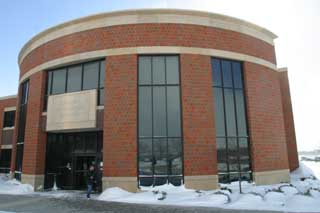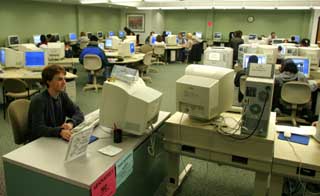
Genesee Community College's Board of Trustees approved the updated facilities and strategic plans last December. The strategic plan, which is reviewed annually, identifies the college's priorities and emerging service needs. One of the initiatives of the plan is the development of Genesee Online. Genesee Online is essentially a virtual campus center that exists in cyberspace, explains Rick Ensman, Director of External Development and Affairs. The college is actively working on it now and it will emerge as a very important force within the college over the next several years. GCC is already offering a number of courses online where students can interact with other students and professors through the web. The goal of Genesee Online, however, is to have the same kind of support, services and programs online that a student would get at a physical campus center. They want students to have an opportunity to sit down with an advisor over the web, obtain financial aid information, register and even participate in online clubs. The world wide web and the internet are becoming part of the fabric of our society and consequently, they are becoming part of the fabric of our education, says Ensman. The strategic plan also projects adding new grant funded programs, more professional development opportunities for faculty and staff and a rigorous evaluation of courses and programs. The college would also like to have more partnerships with community agencies. "Community college is about the community. It's about what the community needs," says Ensman. He says the college already has many such partnerships and programs ranging from Red Cross swimming lessons to consumer related topics done with Cornell Cooperative Extension. And it's not just the traditional credit courses you'll find at GCC, he says. They offer around 350 non-credit courses ranging from historical courses to personal computer courses. The current Batavia campus was built in 1972 (the college was actually established in 1966), but has expanded much over the years. "Fewer and fewer people call it 'the glorified high school on the hill'," says Ensman. "People are beginning to realize that we have put a lot of money into top notch programs and top notch technology. We have over a thousand personal computers on campus. The quality of education, the interaction the students have with faculty and staff, the technology support, the personal quality and the one to one attention students get makes GCC a tremendous place." Facility changes ahead The facilities plan, which is a long range forecast of the college's space needs, noted that the current mechanical systems are outdated. Science labs and electrical systems will also be inadequate to meet the needs in the years ahead. The bookstore and cafeteria area are cramped and there is a growing shortage of student and athletic space. Long-term facility priorities, according to the plan, include updating the mechanical systems and converting many standard classrooms into "smart" classrooms. A "smart" classroom is a fully interactive classroom linked via the world wide web to resources around the world, explains Ensman. The rooms will be equipped with oversized video monitors and document readers so that very small items like microscopic slides can be magnified onto a wall. He says the rooms will contain a whole suite of high-tech interactive tools that literally brings the entire world into the classroom. The facilities plan also includes developing more student activity space to accommodate the increasing number of students as well as to adapt to the shift the college is making toward more of a "residential" campus. A little over a year ago, the college purchased seven apartment buildings to be used for student housing. They now have 235 students living in those and anticipate that number will rise to 275 students next year. Ensman explains that these students need and want to use a variety of college services during non-traditional hours. "It is still a small percentage of the overall student population," says Ensman, "but having students here twenty-four hours a day does change the character of the campus somewhat and is going to drive what we do in terms of construction and adaptations to the campus and to services in the years ahead." The facilities plan also projects: increased opportunities for community access to the college facilities; improvements to the athletic fields; and, eventually, building a field house. "We'd really like to have more large common space so we could have everything from large community meetings to trade shows and business events. There certainly is a community need and a community demand for that," says Ensman. "Also there is a lot of public demand for indoor and outdoor athletic space. Our athletic fields need improvement and expansion and we would like to have more indoor athletic space." It is a State University of New York requirement that all campuses maintain an updated facilities master plan. The facilities plan, developed by architectural firm, Joy, McCoola and Zilch, is a blueprint of the future, says President Stuart Steiner. "The projects identified are not going to happen right away. Eventually, however, we will have opportunities to further develop our facilities to meet the changing needs of our student body and community. Having a well developed plan in hand is one of the best ways to insure that, when the time arrives to upgrade facilities ... we're ready to move ahead fast." |


